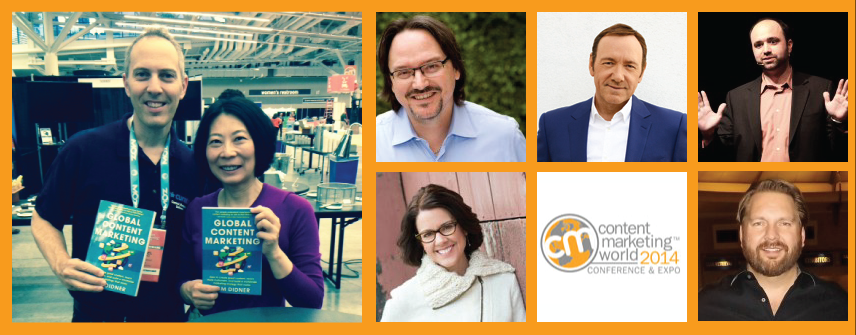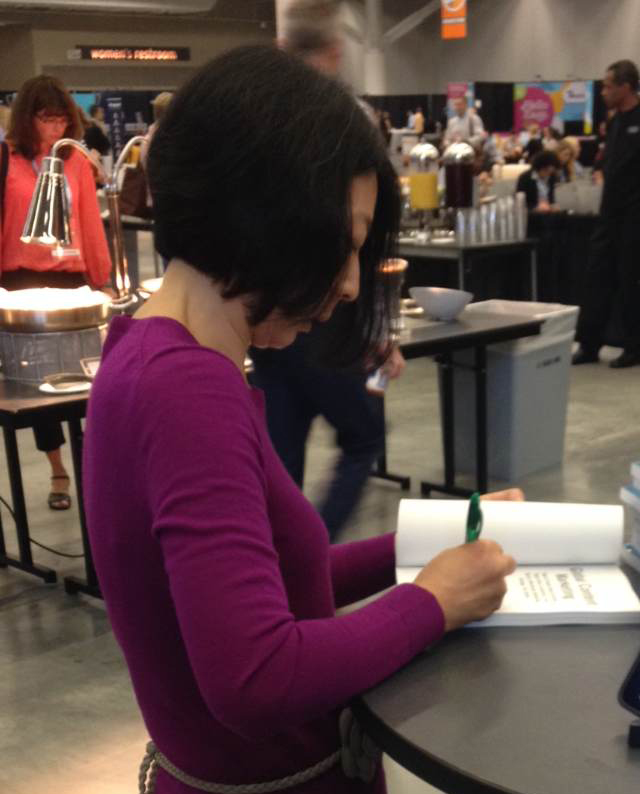- Share Content Marketing World 2014: A Quick Wrap-Up on Facebook
- Share Content Marketing World 2014: A Quick Wrap-Up on Twitter
- Share Content Marketing World 2014: A Quick Wrap-Up on Linkedin
- Share Content Marketing World 2014: A Quick Wrap-Up via email
Content Marketing Institute put on a great conference, gathering over 2,500 content marketers for Content Marketing World 2014. We traveled to Cleveland for a few days of learning, networking and listening.
I had the chance to attend the event for the first time and soak up knowledge from speakers such as Lee Odden, Jay Baer, Todd Wheatland, Shane Snow, Ann Handley and many, many more.
We even got to talk one-on-one with speaker Pam Didner (for our interview with her, refer below).
Here are some recurring themes I found from attending the sessions:
-
- Storytelling is more important than ever, but it must be the right story. Speakers from Andrew Davis to Shane Snow to Kevin Spacey emphasized the power of a story. But, many of the speakers also noted that not any story will do. Stories must have elements of empathy, conflict, character and narrative. Stories must appeal to consumers in a way that will surprise them, and as Andrew Davis said, inspire them to act.
-
- Proving ROI of content is key. The conference kicked off with keynote speaker Julie Fleischer revealing that content brings four times better ROI than traditional advertising at Kraft. The conversation surrounding ROI continued with a speaking track dedicated to the topic. We heard from marketers at companies large and small, but one desire remains consistent: the need for cold, hard data to prove that content aligns to revenue.
-
- Not all content needs to be on owned properties. Although many marketers focus on page views and time spent on their own company websites and blogs, speakers such as Todd Wheatland and Allen Gannett spoke about the value of spreading content to other places, such as SlideShare, LinkedIn and even Vine.
-
- A good content marketing strategy features both created and curated content. Speaker Emmanuel Laroche said the best practice is to supplement created content with curated content. Our own research at Curata says best-in-class marketers use 65% created content, 25% curated content and 10% syndicated content.
Here is a roundup of tweets for some more insights from the event:
“Consumer attention is exponentially fleeting with every Vine, Instagram and Snap” #CMWorld with @jfly pic.twitter.com/AYYIg6Bcg6
— SimpleReach (@SimpleReach) September 9, 2014
“Moments Of Inspiration lead to Return On Investment” Make MOI content “cornerstone content to keep extending. @TPLDrew #cmworld
— Carlos Abler (@Carlos_Abler) September 10, 2014
#cmworld @leeodden ends with this. Awesome. We’ve got this. pic.twitter.com/aPVmW5QdYf
— Social Marketing (@socialhelp) September 11, 2014
Good writing is good thinking – it’s not just about copywriting. @annhandley #cmworld pic.twitter.com/qirUdV2pKL
— Scott Lum (@ScottLum) September 10, 2014
Great #ContentMarketing tools by @iancleary – incentivize social sharing using @PayWithATweet #CMWorld
— Michael Gerard (@michaelgerard) September 10, 2014
“There are no more excuses. Anyone can build an audience. Just do it!” @KevinSpacey #cmworld
— Andrew Davis (@TPLDrew) September 10, 2014
We also hosted Pam Didner at our booth as a part of the launch of her book, Global Content Marketing.
We took advantage of the time she spent signing some copies of her book (Thanks again, Pam!) to conduct an interview with her as well. Five questions, five short answers.
1. There are already quite a few content marketing books out there. Why write yet another one?
We tend to discuss global content marketing from the perspectives of localization and customization of content or in a cultural and language context. These aspects are important, but that’s not all! There is no book about headquarters and regional offices working together or laying out a framework for scaling content from planning, creating and promoting through measuring content. I created the 4 P’s of the Global Content Marketing Cycle and share a step-by-step process for how to scale content in a systematic way.
2. Out of all the case studies in your book, which is the most memorable and valuable for readers?
I like all of them. Heather Zynczak, CMO of Domo, makes content the center of her marketing organization. Her annual marketing strategy aligns with Domo’s business goals and objectives. With clear business goals and marketing strategy, she crisply identifies the target audiences Domo would like to reach to grow its business. Then, she creates an annual content editorial plan to align with marketing objectives and target audiences. Her content planning drives both sales enablement and marketing communications. In addition, she hires a data analyst to measure the effectiveness of marketing. Heather gets the true essence of content marketing.
3. How is global content marketing different from regular content marketing?
It’s a mind set change. If your content will be scaled beyond borders, it’s helpful to take into account other countries’ or regions’ needs before content is created. Some content can scale very easily across borders; some content requires both localization and customization. Some content simply needs to be created locally.
In addition, you will need to collaborate with people in other countries or regions. Compromise, collaboration and communication are absolutely necessary for global content marketing.
4. What is the most painful mistake you have learned as a content marketer?
Oh, there are so many (laugh). Working in a global role, there are a lot of compromises and a lot of give and take. The painful lesson I learned early on is to get everyone aligned on business goals and objectives. If everyone is aligned from the get go, it makes it easier to implement and execute. Headquarters’ job is to serve the regional teams and make them successful. If they are successful, the whole company is successful.
5. I know you recently left Intel after a long stint there. What’s next for you?
I am also using the time to promote my book and speak at marketing conferences and events. I will also spend some time visiting places (e.g. Galapagos) on my bucket list. I am taking the path less traveled and just letting the future unfold.
To learn more about content marketing and curation, sign up for our Curation 101 webinar on September 17th at noon EST.









